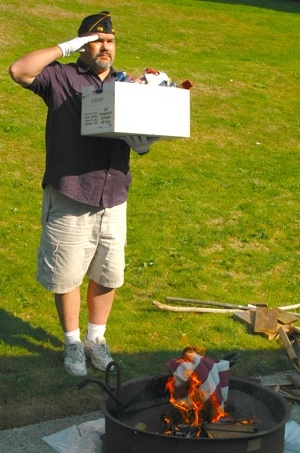MARYSVILLE — On Sept. 11, 2011, Marysville resident Robert Hitchings held the American flag that had been flying from his house in Seattle 10 years ago.
“By the time I moved up here, it was too faded to be flown anymore,” said Hitchings, a Vietnam veteran who retired from the Army in 1986 after 22 years of active duty service. “I got a newer one for Christmas, which I finally got around to putting up just recently.”
Hitchings handed over the no-longer-serviceable flag to the members of Marysville American Legion Post 176 at the pavilion in Jennings Park on the 10th anniversary of the 9/11 terrorist attacks. Marysville Legion members had already received more than 40 flags to dispose of that day, during an afternoon flag retirement ceremony.
“We received more than 100 unserviceable flags to dispose of at last year’s ceremony,” said Tony Campbell, second vice commander of Legion Post 178. “Of course, that was the first year we’d done this. We’re actually lucky that we didn’t receive as many flags this year, because otherwise it’d take us a couple of hours to retire them all, like it did last year. We’re hoping that this year means that we’ve turned it into an annual event.”
Marysville Legion member Jim Eastbury had hosted the ceremony on his Arlington property last year, but with his passing since then, his fellow Legion members changed the venue for both the flag retirement ceremony and their annual pot luck lunch. Another new wrinkle of the second annual Legion flag retirement ceremony is its move from July 25 of last year to Sept. 11 of this year.
“This date joins another infamous day that is seared into our memories, that of the surprise attack at Pearl Harbor on Dec. 7, 1941,” said Ken Cage, commander of Legion Post 178. “We hope that we will be able to do with 9/11 as we have done with Pearl Harbor — never forget, but move on and make the future better.”
As he’d done last year, Cage had invited anyone who owned a flag that had “outlived its usefulness” to contact him to arrange for its proper disposal of those flags.
The preferred method for disposing of an American flag that is deemed no longer serviceable is burning, which the veterans did by placing the flags on an open fire after they had “become faded and worn in a tribute of service and love.” While the participants wore more casual clothes in response to the day’s warm weather, they read from their scripts precisely to conduct the ceremony properly.
“A flag may be a flimsy bit of printed gauze or a beautiful banner of finest silk,” Cage said. “Its intrinsic value may be trifling or great, but its real value is beyond price, for it is a precious symbol of all that we and our comrades have worked for, lived for and died for — a free nation of free men and women, true to the faith of the past, and devoted to the ideals and practice of justice, freedom and democracy.”
Cage explained that, once the flag is reduced to ashes, it’s considered disposed of and there is no additional protocol for the ashes.
“Let these faded flags of our country be retired and destroyed with respectful and honorable rites,” Cage said. “Let their places be taken by bright new flags of the same size and kind, and let no grave of our soldier, sailor, Marine or airman dead be unhonored or unmarked.”



